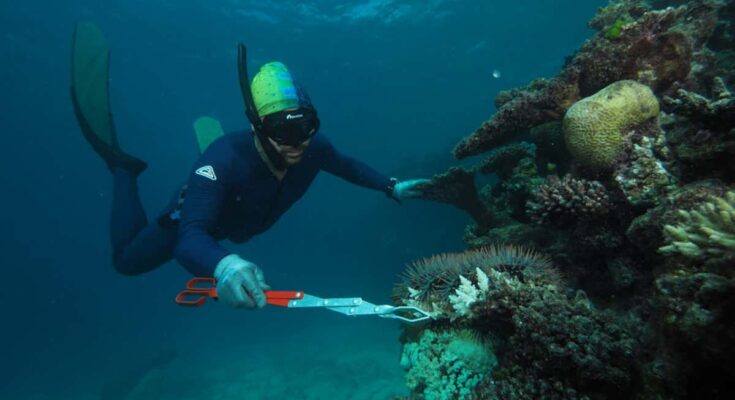A diver pours vinegar on a crown-of-thorns starfish as part of a decapitation program
CSIRO
The culling program has succeeded in protecting key areas of the Great Barrier Reef from coral-eating starfish. Scientists who analyzed the results say that efforts should be expanded to conserve more reefs.
Crown-of-thorns starfish (COTS) feed on almost all coral species in Australia’s Great Barrier Reef. Each starfish can reach one meter in diameter and eat 10 square meters of coral reef every year.
Starfish are native to reefs, but it is thought that increasing nutrients entering reef waters from agriculture and other human factors have increased their numbers and exacerbated coral damage. Between 1985 and 2012, they accounted for 40 percent of the area’s coral loss.
During the period of major volcanic eruptions between 2012 and 2022, the Great Barrier Reef Marine Park Authority undertook a major felling program. Different species groups inject starfish with a single shot of vinegar or ox bile, which kills them and prevents the hatching of larvae.
Roger Beeden at the Park Authority and his colleagues found that in areas where early eradication was carried out, outbreaks were reduced and coral cover recovered and increased in percentage. 44. Where the corals were not cut, it was very heavy. The study also confirmed that by preventing the blasting of the most important reefs, the larvae did not spread in waves to other reefs, meaning that other diseases were reduced.
So far, the program has been focusing on 500 of the 3000 reefs of the marine park, which are scattered throughout the park but have been chosen because they have a significant value in the tourism industry or are known to be important for spreading no starfish.
“The results we got in this study are the result of using integrated pest management to protect ourselves [the starfish] in the right areas at the right time – like plague locusts and other pest control,” says Beeden.
But researchers are recommending that the program expand from its current fleet of five to seven ships to between 10 and 15 ships. “At any given time, of those 500, about a third to a half are playing with current epidemics,” says Beeden.
Terry Hughes, from James Cook University in Townsville, does not believe the depopulation program is good. He says: “It is becoming increasingly clear that efforts to protect the Great Barrier Reef’s coral reefs by breeding crown-of-thorns starfish on a few reefs is just a drop in the ocean.”
Hughes says the regional differences in starfish numbers and coral abundance – which the study says is due to the level of decay in different parts of the Great Barrier Reef – can be explained by which areas are most affected. recent hurricanes and widespread coral bleaching. events. Beeden admits these factors are difficult to separate from the effects of the kill, but says: “Our results are reinforced, and not confounded, by the fact that coral success in the Townsville area has been achieved despite the events two whitewashed masses in 2020 and 2022.”
Instead, the priority should be to deal with global warming, which is causing the rise and fall of coral bleaching, says Hughes. He says: “After every blackout event the Australian government announces more money to kill starfish in a small part of the reef, taking the focus away from dealing with the causes.” of the epidemic, or to reduce greenhouse gas emissions in Australia.
Topics:
#Cutting #starfish #saves #coral #Great #Barrier #Reef


